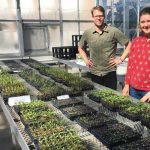BioCycle March/April 2019
2018 Food Recovery Challenge Winners
![]() U.S. EPA announced the 2018 winners of the Food Recovery Challenge — businesses and organizations being recognized for their outstanding efforts and leadership to prevent and divert food waste and promote sustainable management of food. The 2018 awardees utilized various approaches to reduce food waste, such as purchasing only what they need, menu forecasting and creatively preparing meals. Over 1,000 entities, including grocers, restaurants and educational institutions, participate in EPA’s Food Recovery Challenge. Participants pledge to improve their food management practices and report their results.
U.S. EPA announced the 2018 winners of the Food Recovery Challenge — businesses and organizations being recognized for their outstanding efforts and leadership to prevent and divert food waste and promote sustainable management of food. The 2018 awardees utilized various approaches to reduce food waste, such as purchasing only what they need, menu forecasting and creatively preparing meals. Over 1,000 entities, including grocers, restaurants and educational institutions, participate in EPA’s Food Recovery Challenge. Participants pledge to improve their food management practices and report their results.
In 2017, participants prevented or diverted almost 648,000 tons of food from entering landfills or incinerators, saving up to $31.2 million in avoided landfill fees; benefitted communities with donations of 214,000 tons of food; sent nearly 170,000 tons of food to anaerobic digestion facilities; and composted more than 234,000 tons of food. Food Recovery Challenge awards are offered in two categories — data driven and narrative.
Plant Based Products Council
The Plant Based Products Council (PBPC) was launched by a group of businesses and environmental leaders in January to promote the adoption and use of products derived from renewable biomass. The group will advocate for private sector programs and government policies to reduce carbon emissions, improve water quality and soil health, and curtail solid waste destined for landfills by purposeful closed loop end-of-life strategies through recycling and composting. PBPC’s membership includes large and small businesses from across the U.S. that produce, distribute, or sell products/packaging from renewable biomass inputs, as well as organizations that have made related public commitments to build a more sustainable future.
Polling, conducted in August 2018 and recently released by the PBPC, reinforces the notion that millennial consumers are supportive of bioplastics and even willing to pay more for them. Findings include:
• 48% of millennials feel most guilty about their own plastic use compared to other resources, such as paper (33%), water (31%) or the amount they drive (19%).
• 64% of millennials are willing to use alternatives to plastic.
• 60% of millennials surprised by the lack of alternative options to plastic.
• While only 13% are “very familiar” with bioplastic, once described, 90% become favorable to bioplastics.
Potential Of Insects For Scottish Fish Farms
The black soldier fly has been highlighted in a new report as a potential and plentiful protein source for Scottish fish farms. Salmon farming, Scotland’s second biggest food export industry, uses huge volumes of feed, much sourced from wild caught fish. In July 2017, the European Union passed legislation allowing use of insect meal for feed in aquaculture. This follows similar legislative changes in Canada and the U.S., where insect meal, primarily derived from Black Soldier Fly (BSF) larvae, is now displacing fish meal in the salmon farming industry. BSF larvae are voracious consumers of organic material (see “Bugs Eat Our Food Waste”).
Extensive testing has shown BSF do not carry human or livestock diseases, nor are they an invasive species risk in northern climates. BSF farming can rapidly convert large quantities of preconsumer food waste and by-products into high quality protein, while insect frass (manure) can be used as a soil enhancer similar to compost. This presents two potential opportunities for Scotland, a protein supply for the aquaculture industry and another method of organic waste treatment.
The report, prepared by Zero Waste Scotland, found that processing preconsumer food waste with BSF at a gate fee similar to anaerobic digestion (AD), could yield significant returns in terms of protein value for fish feed, and would have an additional 10 percent carbon reduction benefit over AD. They also found that if the maintenance temperature of BSF farming (about 30°C or 86°F) could be provided by recovered waste heat, the carbon reduction benefits would double.
UK Fund Supports Smart Packaging Innovation
Household food scraps could be transformed into sustainable packaging with up to £60 million ($76 million) of new government funding in the United Kingdom. Innovators are being challenged to make the UK a world leader in creating sustainable packaging and reduce the impact of harmful plastics on the environment, as part of the UK’s Industrial Strategy. The funding, according to UK Research and Innovation, could help develop:
- New forms of packaging and plastic made from farming, food and industrial waste, like sugar beet, wood chippings and food waste
- Smart packaging labels, which, alongside a smart bin, could tell consumers the right bin to put recycling into and revolutionize the way recycling is sorted in waste plants
- “Live” sell-by-date patch — a living sell-by-date that deteriorates at the same rate as produce to show consumers when their food is going off — cutting down on food waste.
Disposable-Free Dining Ordinance
 The Berkeley (California) City Council unanimously passed the Disposable-Free Dining Ordinance in January, a “groundbreaking and expansive plan” for phasing out single-use plastic foodware from Berkeley restaurants and businesses, reports BreakFreeFromPlastic.org, a Zero Waste advocacy group. The ordinance, the first of its kind in the U.S. to comprehensively address single-use plastics, immediately requires items like utensils, straws, lids, and sleeves to be provided by request or at self-serve stations, and for food vendors to have bins for compostables for customers. By January 1, 2020,the ordinance requires all disposable takeout foodware to be 100 percent BPI-certified compostable; all eat-in dining establishments use reusable foodware; and all vendors charge $0.25 cents for hot and cold take-out cups. If customers provide their own cups, the charge is not applied.
The Berkeley (California) City Council unanimously passed the Disposable-Free Dining Ordinance in January, a “groundbreaking and expansive plan” for phasing out single-use plastic foodware from Berkeley restaurants and businesses, reports BreakFreeFromPlastic.org, a Zero Waste advocacy group. The ordinance, the first of its kind in the U.S. to comprehensively address single-use plastics, immediately requires items like utensils, straws, lids, and sleeves to be provided by request or at self-serve stations, and for food vendors to have bins for compostables for customers. By January 1, 2020,the ordinance requires all disposable takeout foodware to be 100 percent BPI-certified compostable; all eat-in dining establishments use reusable foodware; and all vendors charge $0.25 cents for hot and cold take-out cups. If customers provide their own cups, the charge is not applied.
Businesses keep the $0.25 cup tax and can reinvest that revenue into upgrading their equipment. Additionally, the city is offering small grants to support business compliance. Possible waivers may be available for hard to attain take-out containers.
Human Error Cause Of Food Waste In Manufacturing
Researchers at Brunel University in England and Ghent University in Belgium studied production processes at 47 food manufacturers in Belgium to determine where the highest losses were observed. They found that human error accounted for 10.9 percent of all food waste lost, second only to the 13.9 percent loss recorded as a result of changing the food output from one product to another, e.g., from a tomato sauce to a mustard sauce, according to an article in inbev.com. “It’s a management issue,” explained Dr. Manoj Dora of Brunel Business School, who led the study. “In many instances, there wasn’t proper training, or a standardization of work being applied in their workplace.” This led to a greater tendency towards errors, and thus, more food waste.
Data was gathered from a variety of companies, ranging from ready meal makers to drinks manufacturers. On average, the manufacturers suffer a loss of 1.1 tons of food for every 38.5 tons they produce. Other points of loss during production include product defects (8.7%) and changes in buyer contracts (6.4%). One of the most interesting findings, noted the researchers, was how unaware many manufacturers — particularly smaller ones — were of how much food they were wasting.
Restaurants Save By Reducing Food Waste
A February 2019 report, “The Business Case for Reducing Food Loss and Waste: Restaurants,” reveals a compelling business case for restaurants to reduce food waste. For every $1 restaurants invested in programs to reduce kitchen food waste, on average they saved $7 in operating costs, notes the report by Champions 12.3, in partnership with the Walmart Foundation, the Netherlands Ministry of Agriculture, Nature, and Food Quality, the UK’s Waste and Resources Action Programme (WRAP), and World Resources Institute.
Champions 12.3 is a coalition of executives from governments, businesses, international organizations, research institutions, farmer groups, and civil society dedicated to accelerating progress toward achieving the United Nation’s Sustainable Development Goal Target 12.3 by 2030. The coalition analyzed data of preconsumer waste from 114 restaurant sites, located across 12 countries, and calculated the following results:
- Average benefit-cost ratio for food waste reduction was 7:1 over a three-year time frame.
- Within the first year of implementing a food waste reduction program, 76 percent of the sites had recouped their investment. Within two years of implementing a program, 89 percent of the sites had recouped their investment.
- By reducing food waste, the average site saved more than two cents on every dollar of cost of goods sold.
- There appears to be no clear correlation between benefit-cost ratios and a site’s market segment or geography.
- Key strategies for achieving food waste reduction were to measure the food waste, engage staff, reduce food overproduction, rethink inventory and purchasing practices, and repurpose excess food.
The types of investments restaurants made included measuring and monitoring the amount of food wasted, training staff on new food handling and storage procedures and redesigning menus. Every site was able to keep their total investment below $20,000, indicating that the cost of change was low, and benefits were high for all businesses assessed.
Recycling Biosolids To Make Sustainable Bricks
A team at RMIT University in Melbourne, Australia, has demonstrated that fired-clay bricks incorporating biosolids could be a sustainable solution for both the wastewater treatment and brickmaking industries. Led by Assoc. Prof. Abbas Mohajerani, the RMIT University team recently created a number of such bricks, which incorporated from 10 to 25 percent biosolids. Published in the journal Buildings in January 2019, the research showed how making biosolids bricks only required around half the energy of conventional bricks. As well as being cheaper to produce, the partially biosolids bricks are more porous and therefore less thermally conductive. Buildings constructed with them will need less heating and cooling.
The RMIT researchers also observed that 43 to 99 percent of heavy metals present in the biosolids were trapped within the bricks, keeping them from entering the environment. Concentrations of heavy metals that did leach out of the bricks were said to be insignificant.
Zero Hunger Zero Waste Innovation Fund
 The Kroger Co. announced the launch of the Zero Hunger Zero Waste Innovation Fund designed to end hunger in communities where its stores are located and eliminate waste in all stores and across the company by 2025. The company’s plan includes establishing a $10 million innovation fund through The Kroger Co. Foundation; accelerating food donations to 3 billion meals by 2025; advocate for public policy solutions to address hunger and help divert food wastes from landfills; and partner with existing and new partners like Feeding America and World Wildlife Fund. During the launch, Kroger announced a competitive grant program, prioritizing emerging technologies and ideas focused on food waste prevention. Grant recipients will be announced in Spring 2019.
The Kroger Co. announced the launch of the Zero Hunger Zero Waste Innovation Fund designed to end hunger in communities where its stores are located and eliminate waste in all stores and across the company by 2025. The company’s plan includes establishing a $10 million innovation fund through The Kroger Co. Foundation; accelerating food donations to 3 billion meals by 2025; advocate for public policy solutions to address hunger and help divert food wastes from landfills; and partner with existing and new partners like Feeding America and World Wildlife Fund. During the launch, Kroger announced a competitive grant program, prioritizing emerging technologies and ideas focused on food waste prevention. Grant recipients will be announced in Spring 2019.










